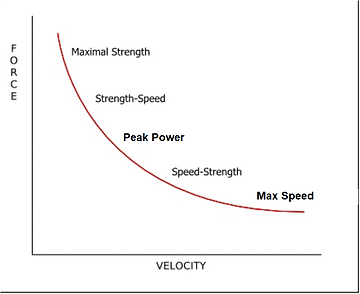In our last Elite Training post we introduced you to Velocity Based Training (VBT) and how we use that at CTG. This week we want to get more in depth on what each of these zones means and how it’s important to the elite athlete’s training plan.
That’s What My Lift Said
The SAID Principle is a training concept that has been around for as long as any of us has been. The idea is that training needs to be geared toward the outcome you want to achieve; you can’t get mad ups if you only ever do biceps curls.
In VBT we can determine where an athlete can improve based on their Force-Velocity profile, what their specific sport needs are, and then a program can be designed for them based on velocity zones. This allows athletes to optimize their time spent in the weight room and yield positive adaptations.
The Force-velocity Curve Is A Strong One

As force decreases, velocity increases. That’s why training for maximal or absolute strength looks different than training for maximum speed. However, with training and as an athlete becomes more proficient in their movement patterns, this curve can make a shift to the right with improvement in all areas.
Athletes who have a skewed Force-Velocity curve are demonstrating variable strengths and that allows the coach to determine areas of obvious improvement over others. During an annual training plan different periodized segments will focus on different velocity zones. Collecting data using the PERCH System allows athletes to improve in areas specific to their sport needs.
Squat
Let’s take a closer look at each zone and what just one movement pattern, the Squat, would look like for each zone.
In the video below you can see the weight increase as the velocity decreases. The parameters listed here help to visualize the correlation to 1RM training.
Max Strength: Bar speed <0.5 m/s (80%+ 1RM) – heavy loads/moving slowly
Accelerative Strength: Bar speed 0.5 m/s – 0.75 m/s (60-80% 1RM) – relatively heavy load/moving slowly (emphasize concentric as fast as possible)
Strength-Speed: Bar speed 0.75 m/s – 1.0 m/s (40-60% 1RM) – moderate load/moving as fast as possible (power) – priority is strength, speed 2nd
Speed-Strength: Bar speed 1.0 – 1.3 m/s (40-60%) – light load/as fast as possible
Speed: Bar speed > 1.3 m/s (15-40%) – minimal load/fast as possible (starting strength)
Using the PERCH training system CTG Coaches can monitor your lifts and determine if you’re registering in the blue zone (hitting the training goal) or the red zone (below the training goal). Based on your performance, the coach will terminate a set when mean concentric velocity falls below predefined value to maximize gains. Coaches will also add additional load if you’re above the mean concentric velocity.
This technology is only available at Change the Game and in the Elite Athlete Training Program.
Open Tryouts Are Coming Up March 20-25 With Only 10 Spots Open In Our Program.



